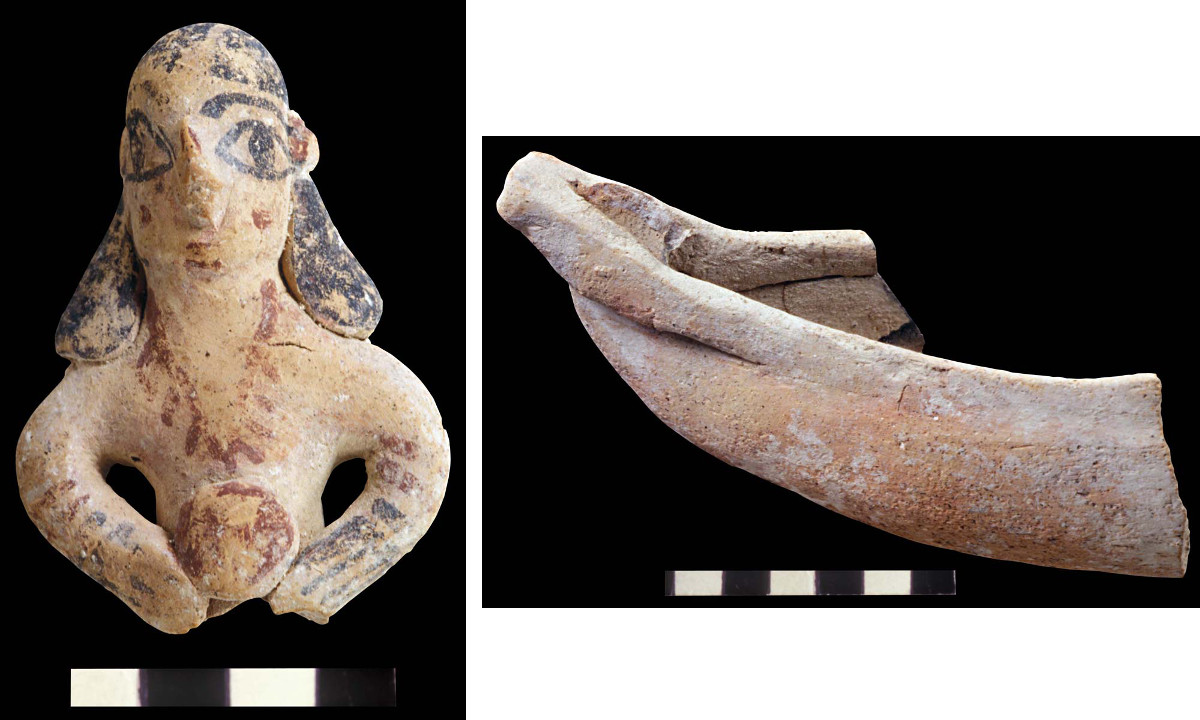In the field of coroplastics the discoveries made by the French expedition on the acropolis (the sanctuary of Aphrodite, the West Terrace, the palace) within the vicinity of the fortification structures (acropolis middle fortification wall and North wall) along with the lower town (agora) allowed us to amass extensive and abundant documentation that complements the finds the Department of Antiquities unearthed in the necropoleis.

Palace, figurine of a woman with disc (Ph. Collet / Archives EFA, Y.2127) – Palace, boat fragment (Ph. Collet / Archives EFA, Y.2024)
The artisanal trade of making terracotta figurines for votive or funeral purposes was very widespread in Cyprus where stone sculpting material of good quality was relatively uncommon. Just as with many of the other city-kingdoms on the island, beginning in the Archaic period, Amathus developed a distinctive style that is reflected in its wares, either figurines modeled directly or of clay pressed into a mould, or else masks and busts made from a hollow casting mould. Even if they had reached other parts of the island, specific iconographic types were especially favored by the Amathusian coroplasts, most probably because of their connection to the cult of the acropolis sanctuary: the figurines that represent Astarte, personification of the Great Goddess, but also those fashioned after the offering-bearers as well as other personages depicted in all manner of gestures or else little terracotta boats.
![Sanctuary, Tanagra-style head (Ph. Collet / Archives EFA, Y.1763) - Fragment of a polychrome figurine, watercolour (S. Hartmann / Archives EFA, 12827 [7])](http://www.efa.gr/storage/2015/09/amathonte_Y1763_12827.jpg)
Sanctuary, Tanagra-style head (Ph. Collet / Archives EFA, Y.1763) – Fragment of a polychrome figurine, watercolour (S. Hartmann / Archives EFA, 12827 [7])
Coroplastics production at Amathus did not dry up with the demise of the kingdom and transition to the Hellenistic period. A sizeable deposit of terracotta wares was found in 1979 in the vicinity of the central gate of the middle wall, in conjunction with the finds from the sanctuary of Aphrodite, that points to the development of this craft in the direction of other techniques, iconography and models: new divinities (above all Isis) accompanied by traditional renderings of musicians or kourotrophoi, in a style that is markedly imbued with Egyptian and Greek influences and a pronounced taste for polychromy of which the deposit at the middle wall preserved outstanding specimens.
A. Cannavò, trans. A.M. Schroth-Daskalakis
